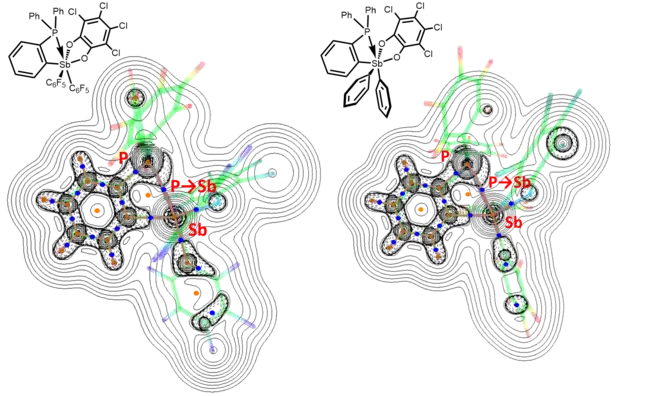Lewis acidic antimony compounds
Among pnictogen group Lewis acidic compounds,[1][2][3][4] unusual lewis acidity of Lewis acidic antimony compounds have long been exploited as both i) stable conjugate acids of non-coordinating anions (SbF6- and Sb2F11-)[5] and ii) strong Lewis acid counterparts of well-known superacids (magic acids, fluoroantimonic acid). Also, Lewis acidic antimony compounds have recently been investigated to extend the chemistry of boron because of i) the isolobal analogy between vacant p orbital of borane and σ* (Sb-X) orbitals of stiborane and ii) the similar electronegativities of antimony (2.05) and boron (2.04).[6]
Origin of acidity
3-P(O)Ph3).png.webp)
σ* (Sb-X), where X describes substituents on Antimony, contributes to the Lewis acidity of antimony compounds in two ways: Donor-Acceptor orbital interaction and Electrostatic interaction. These two contributions to the Lewis acidity have been evaluated. Each contributions are studied by calculations, and the acidities of theses compounds are quantified by the Gutmann-Beckett method, Hammett acidity function, pKa, and fluoride ion affinity (FIA). FIA is defined as the amount of energy released upon binding a fluoride ion in gas phase. FIA of two popular strong Lewis acids, BF3 and B(C6F5)3, are 81 kcal/mol and 106 kcal/mol, respectively.[5]
Donor-Acceptor orbital overlap
Since Lewis adducts are formed by dative bond between Lewis bases and Lewis acids, the orbital overlap between the Lewis base and σ* (Sb-X) orbital is the source of the acidity. According to the Gabbai and coworkers, NBO analysis of the Sb(C6F5)3-P(O)Ph3 adduct indicates a donor-acceptor interaction between lp(O) and σ*(Sb-C6F5).[7][8]
Lowering the LUMO (σ* (Sb-X)) energy increases the Lewis acidity. For example, Sb(C6H5)3 has higher LUMO energy (-0.55 eV) and weaker FIA (59 kcal/mol) than Sb(C6F5)3 (LUMO: -1.76 eV, FIA: 89 kcal/mol).[7]
Electrostatic interaction
Partial positive charges on the surface of antimony compounds interact with partial negative charges. For example, Sb(C6F5)3(o-O2C6Cl4) has a more positively charged site than Sb(C6F5)3 as shown in its electrostatic potential map, corresponding to higher Lewis acidity (FIA of Sb(C6F5)3(o-O2C6Cl4) and Sb(C6F5)3 are 116 kcal/mol and 89 kcal/mol, respectively).[7]
3%252CSb(C6F5)3(Catecholate)_ESP.png.webp)
Structure of Lewis acidic antimony compounds
Lewis acidic antimony complexes with a variety of oxidation states and coordination numbers are known. Several salient examples are introduced below.

Cp*_IBOs.png.webp)
3-coordinate Sb(III)
Although stibanes have a lone pair electrons, their anti-bonding orbitals with electron-withdrawing substituents renders it Lewis acidic. Sb(C6F5)3 (3) has three σ*(Sb-C6F5) orbitals and three Lewis acidic sites. However, as shown in the electrostatic potential map of Sb(C6F5)3, only one site is accessible to Lewis bases due to the asymmetric arrangement of three aryl rings.[10]
In [Sb(tol)(Cp*)]2+(1), the η5-Cp* binding mode is confirmed using IBO analysis. In the solid state structure, the Sb-C bond distances between Sb and carbons in the Cp* ring are 2.394(4) ~ 2.424(4) Å, but the Sb-C bond distances between Sb and carbons in the toluene are 2.993(5) ~ 3.182(5) Å. This longer Sb-toluene distance implies toluene lability in solution.[9]
Sb2(o-catecholate)2(μ-O) (2) had been predicted that lewis base would bind to two antimony centers in a bridging manner. However, it was observed that 2 binds with halide anion in various ratio (3:1, 2:1, 1:1, 1:2, 1:3). Cozzolono and coworkers suggested three reasons for its complex binding mode. First, a rotational freedom around bridge oxygen disrupts a Lewis base binding between two antimony centers. Second, intramolecular interactions between oxygen at catecholate and antimony competes with external Lewis base binding. Third, high polar and nucleophilic solvent, DMSO, is required to dissolve 2 due to the solubility and the solvent is also able to bind at antimony.[11]
3-coordinate Sb(V)
[SbPh3]2+ (4) was not isolated. Instead, its Lewis adducts, [SbPh3(OPPh3)2]2+ and [SbPh3(dmap)2(OTf)]+, were isolated. In the trigonal bipyramidal [SbPh3(OPPh3)2]2+, two OPPh3 are located in axial positions and the Sb-O bond distance (2.102(2) Å) is similar to the sum of the covalent radii of Sb and O (2.05 Å). In distorted octahedral [SbPh3(dmap)2(OTf)]+, Sb-N(dmap) distance (2.222(2) Å) is shorter than reported N-Sb+ distances. This bond distance implies Lewis adduct formation. In addition, a reaction between dmap and [SbPh3(OPPh3)2]2+ forms [SbPh3(dmap)2(OTf)]+. The experimental results indicate that [SbPh3]2+ is the Lewis acidic counterpart of these adducts.[12]
4-coordinate Sb(V)
Tetrahedral stibonium cations also show Lewis acidity. Since Sb(C6F5)4+ (5) forms an adduct with triflate, Sb(C6F5)4+ can be isolated as [Sb(C6F5)4][B(C6F5)4] salt. Short Sb-C bond distances of 2.095(2) Å and a tetrahedral space group of crystal proved that isolated Sb(C6F5)4+ is completely free of external electron donors. This cationic antimony Lewis acid shows strong acidity: i) Sb(C6F5)4+ abstracts fluoride anion from weakly coordinating anions, SbF6-, and ii) the acidity measured by Gutmann-Beckett method of Sb(C6F5)4+ (5) is comparable with that of the B(C6F5)3 adduct in CH2Cl2 (76.6 ppm).[13]
SbPh3(Ant)+ (6) (Ant = 9-Anthryl) was isolated as triflate salt. 6 has a tetrahedral structure like 5. In a solid state structure of a fluoride adduct, AntPh3SbF, incoming fluoride occupies axial position of TBP structure and sterically demanding anthryl is located at the equatorial site.[14]
5-coordinate Sb(V)
Neutral Sb(V) complexes are also Lewis acids.[15] Compounds 7, 8 and 11 shares structure of spirocyclic stiborane. LUMO of 8 mainly has its lobe at the antimony atoms and it renders 8 Lewis acidic. In detail, the LUMO can be assigned to as localized orbital on stiborafluorene moiety with larger nodes at 9-position (Sb). Thus, Lewis bases bind towards trans to biphenylene and its fluoride adducts are asymmetric: 8-F- has two enantiomers and 7-F- has two diastereomers and four enantiomers.
A bis-antimony complex (9) is synthesized starting from Xanthene. 9 has C2 symmetry and Sb-Sb distance is 4.7805(7) Å. Each antimony (V) centers have distorted square pyramidal geometry of τ5 (geometry index)= 0.08. Base plane of each antimony centers meet face to face and this geometry allows 1:1 binding with F- unlike 2[16].
Trends in acidity
Inductive effect
Introduction of electron-withdrawing substituents on antimony results in increased acidity. For example, intramolecular donor-acceptor interactions of two stiboranes (o-C6H4(PPh2)(SbPh2(O2C6Cl4) and o-C6H4(PPh2)(Sb(C6F5)2(O2C6Cl4)) were analyzed by AIM. AIM analysis (Electron density at the bond critical point (bcp) and delocalization index) indicates that electron-withdrawing substituents on Sb (V) lead to an increased P-Sb bonding covalency.[17]
| P-Sb bonding | o-C6H4(PPh2)(Sb(C6F5)2(O2C6Cl4) | o-C6H4(PPh2)(Sb(C6H5)2(O2C6Cl4) |
|---|---|---|
| Electron density at the bcp(e/rBohr3) | 0.054 | 0.035 |
| Delocalization index | 0.38 | 0.24 |

_esp.png.webp)
Bis-antimony compounds vs mono-antimony compounds
A bis-antimony complex (9) is a stronger Lewis acid than a mono-antimony compound (8) because both Lewis acidic sites cooperatively contribute to the Lewis base binding. The electrostatic potential map of 9 shows positive charges on Sb centers facing each other.
This cooperativity is supported by the Sb-(μ-F)-Sb moiety in solid state structure of F- binding bis-anitimony compound 9.[16]
Applications
Fluoride anion sensor
Owing to their high fluoride ion affinity, Lewis acidic antimony compounds may be utilized in fluoride anion sensing. 9-anthryltriphenylstibonium cation (5) shows weak emission (Φ = 0.7%), but a corresponding fluoride adduct, fluorostiborane, shows strong anthryl-based emission at 427 nm (Φ = 9.5% in CHCl3). Owing to its stability in water, 5 can be used as an aqueous fluoride sensor.[14][15] Owing to its fluorescence turn-on response to fluoride binding, as little as 1 ppm of F- can be detected with naked eyes, which have not been achieved by previously reported fluorescent boron compounds with high FIA.[15][18]

In addition, fluoride-selective electrodes were developed by using Lewis acidic antimony compounds as ionophores.[19]
Catalysis

Strongly acidic antimony compounds are able to catalyze organic transformations (e.g. the transfer hydrogenation and the Ritter reaction). Interestingly, Sb(C6F5)3 shows high catalytic efficiency compared to its acidity because the π-acidity of its aryl ring also plays a role in catalysis.[7]
Tetraaryl stibonium cations catalyze cycloadditions between epoxides and CO2 or isocyanate to produce oxazolidinones.[20]
Transition metal complexes

Lewis acidic antimony compounds can act as Z-type ligands. Owing to the strong σ-accepting ability of dicationic Sb ligand, a gold-antimony complex can catalyze styrene polymerization and hydroamination after being activated by AgNTf2.[21]
See also
References
- Caputo, C. B.; Hounjet, L. J.; Dobrovetsky, R.; Stephan, D. W. (2013-09-20). "Lewis Acidity of Organofluorophosphonium Salts: Hydrodefluorination by a Saturated Acceptor". Science. 341 (6152): 1374–1377. Bibcode:2013Sci...341.1374C. doi:10.1126/science.1241764. ISSN 0036-8075. PMID 24052304. S2CID 35796905.
- Bayne, J. M.; Stephan, D. W. (2016). "Phosphorus Lewis acids: emerging reactivity and applications in catalysis". Chemical Society Reviews. 45 (4): 765–774. doi:10.1039/C5CS00516G. ISSN 0306-0012. PMID 26255595.
- Zhou, Jiliang; Liu, Liu Leo; Cao, Levy L.; Stephan, Douglas W. (2019-04-08). "The Arene‐Stabilized η 5 ‐Pentamethylcyclopentadienyl Arsenic Dication [(η 5 ‐Cp*)As(toluene)] 2+". Angewandte Chemie International Edition. 58 (16): 5407–5412. doi:10.1002/anie.201902039. ISSN 1433-7851. PMID 30802353.
- Ramler, Jacqueline; Hofmann, Klaus; Lichtenberg, Crispin (2019-12-31). "Neutral and Cationic Bismuth Compounds: Structure, Heteroaromaticity, and Lewis Acidity of Bismepines". Inorganic Chemistry. 59 (6): 3367–3376. doi:10.1021/acs.inorgchem.9b03189. ISSN 0020-1669. PMID 31891491.
- Krossing, Ingo; Raabe, Ines (2004-04-13). "Noncoordinating Anions—Fact or Fiction? A Survey of Likely Candidates". Angewandte Chemie International Edition. 43 (16): 2066–2090. doi:10.1002/anie.200300620. ISSN 1433-7851. PMID 15083452.
- Marczenko, Katherine M.; Zurakowski, Joseph A.; Bamford, Karlee L.; MacMillan, Joshua W. M.; Chitnis, Saurabh S. (2019-12-09). "Hydrostibination". Angewandte Chemie International Edition. 58 (50): 18096–18101. doi:10.1002/anie.201911842. ISSN 1433-7851. PMID 31591801.
- Yang, Mengxi; Tofan, Daniel; Chen, Chang‐Hong; Jack, Kevin M.; Gabbaï, François P. (2018-10-15). "Digging the Sigma‐Hole of Organoantimony Lewis Acids by Oxidation". Angewandte Chemie International Edition. 57 (42): 13868–13872. doi:10.1002/anie.201808551. ISSN 1433-7851. PMID 30151881.
- Glendening, Eric D.; Landis, Clark R.; Weinhold, Frank (January 2012). "Natural bond orbital methods". WIREs Computational Molecular Science. 2 (1): 1–42. doi:10.1002/wcms.51. ISSN 1759-0876. S2CID 95586513.
- Zhou, Jiliang; Kim, Hyehwang; Liu, Liu Leo; Cao, Levy L.; Stephan, Douglas W. (2020). "An arene-stabilized η 5 -pentamethylcyclopentadienyl antimony dication acts as a source of Sb + or Sb 3+ cations". Chemical Communications. 56 (85): 12953–12956. doi:10.1039/D0CC02710C. ISSN 1359-7345. PMID 32985631.
- Benz, Sebastian; Poblador-Bahamonde, Amalia I.; Low-Ders, Nicolas; Matile, Stefan (2018-05-04). "Catalysis with Pnictogen, Chalcogen, and Halogen Bonds". Angewandte Chemie International Edition. 57 (19): 5408–5412. doi:10.1002/anie.201801452. PMC 5947745. PMID 29558562.
- Qiu, J.; Song, B.; Li, X.; Cozzolino, A. F. (2018). "Solution and gas phase evidence of anion binding through the secondary bonding interactions of a bidentate bis-antimony( iii ) anion receptor". Physical Chemistry Chemical Physics. 20 (1): 46–50. Bibcode:2018PCCP...20...46Q. doi:10.1039/C7CP05933G. ISSN 1463-9076. PMID 29226921.
- Robertson, Alasdair P. M.; Burford, Neil; McDonald, Robert; Ferguson, Michael J. (2014-03-24). "Coordination Complexes of Ph 3 Sb 2+ and Ph 3 Bi 2+ : Beyond Pnictonium Cations". Angewandte Chemie International Edition. 53 (13): 3480–3483. doi:10.1002/anie.201310613.
- Pan, Baofei; Gabbaï, François P. (2014-07-09). "[Sb(C 6 F 5 ) 4 ][B(C 6 F 5 ) 4 ]: An Air Stable, Lewis Acidic Stibonium Salt That Activates Strong Element-Fluorine Bonds". Journal of the American Chemical Society. 136 (27): 9564–9567. doi:10.1021/ja505214m. ISSN 0002-7863. PMID 24946107.
- Ke, Iou-Sheng; Myahkostupov, Mykhaylo; Castellano, Felix N.; Gabbaï, François P. (2012-09-19). "Stibonium Ions for the Fluorescence Turn-On Sensing of F – in Drinking Water at Parts per Million Concentrations". Journal of the American Chemical Society. 134 (37): 15309–15311. doi:10.1021/ja308194w. ISSN 0002-7863. PMID 22954306.
- Hirai, Masato; Gabbaï, François P. (2014). "Lewis acidic stiborafluorenes for the fluorescence turn-on sensing of fluoride in drinking water at ppm concentrations". Chem. Sci. 5 (5): 1886–1893. doi:10.1039/c4sc00343h. hdl:1969.1/185530. ISSN 2041-6520.
- Hirai, Masato; Gabbaï, François P. (2015-01-19). "Squeezing Fluoride out of Water with a Neutral Bidentate Antimony(V) Lewis Acid". Angewandte Chemie (in German). 127 (4): 1221–1225. doi:10.1002/ange.201410085. PMID 25424599.
- Tofan, Daniel; Gabbaï, François P. (2016). "Fluorinated antimony( v ) derivatives: strong Lewis acidic properties and application to the complexation of formaldehyde in aqueous solutions". Chemical Science. 7 (11): 6768–6778. doi:10.1039/C6SC02558G. ISSN 2041-6520. PMC 5363782. PMID 28451122.
- Lee, Min Hyung; Agou, Tomohiro; Kobayashi, Junji; Kawashima, Takayuki; Gabba?, Fran?ois P. (2007). "Fluoride ion complexation by a cationic borane in aqueous solution". Chemical Communications (11): 1133–5. doi:10.1039/b616814k. ISSN 1359-7345. PMID 17347716.
- Li, Long; Zhang, Yihao; Li, Ying; Duan, Yinghui; Qian, Yi; Zhang, Peidong; Guo, Qingjie; Ding, Jiawang (2020-10-28). "Polymeric Membrane Fluoride-Selective Electrodes Using Lewis Acidic Organo-Antimony(V) Compounds as Ionophores". ACS Sensors. 5 (11): 3465–3473. doi:10.1021/acssensors.0c01481. PMID 33112603.
- Yang, Mengxi; Pati, Nilanjana; Bélanger-Chabot, Guillaume; Hirai, Masato; Gabbaï, François P. (2018). "Influence of the catalyst structure in the cycloaddition of isocyanates to oxiranes promoted by tetraarylstibonium cations". Dalton Transactions. 47 (34): 11843–11850. doi:10.1039/C8DT00702K. ISSN 1477-9226. PMID 29697133.
- Lo, Ying‐Hao; Gabbaï, François P. (2019-07-22). "An Antimony(V) Dication as a Z‐Type Ligand: Turning on Styrene Activation at Gold". Angewandte Chemie International Edition. 58 (30): 10194–10197. doi:10.1002/anie.201903964. ISSN 1433-7851. PMID 31111593.